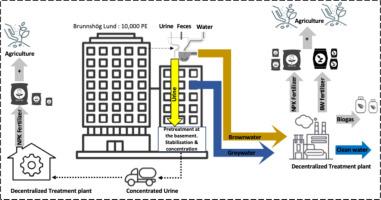当前位置:
X-MOL 学术
›
Water Res.
›
论文详情
Our official English website, www.x-mol.net, welcomes your
feedback! (Note: you will need to create a separate account there.)
Consequential life cycle assessment of urban source-separating sanitation systems complementing centralized wastewater treatment in Lund, Sweden
Water Research ( IF 11.4 ) Pub Date : 2024-11-03 , DOI: 10.1016/j.watres.2024.122741 Abdulhamid Aliahmad, Priscila de Morais Lima, Hamse Kjerstadius, Prithvi Simha, Björn Vinnerås, Jennifer McConville
Water Research ( IF 11.4 ) Pub Date : 2024-11-03 , DOI: 10.1016/j.watres.2024.122741 Abdulhamid Aliahmad, Priscila de Morais Lima, Hamse Kjerstadius, Prithvi Simha, Björn Vinnerås, Jennifer McConville

|
This study examined various source-separating sanitation systems to evaluate their environmental performance, providing decision-makers with insights for selecting an appropriate system for a newly developed neighborhood in Sweden. A full consequential LCA was conducted to account for resource recovery and substitution. The local wastewater treatment plant WWTP was modeled as a reference. Secondly, a urine recycling system was introduced to treat 75 % of the collected urine, with the remainder piped to the WWTP. Thirdly, a black and greywater (BW&GW) treatment system handling all generated wastewater was examined. Finally, a hybrid source-separating system combining urine, black, and greywater was investigated. The results indicated that the four scenarios exhibited global warming potentials (GWP) of 78, 62, 32, and 24 kg CO2-eq per PE/ y. Recycling urine as fertilizer led to a 20 % reduction in the GWP of the reference. It also reduced other impact categories, with a 55 %, 65 %, and 45 % reduction in eutrophication, ozone depletion, and acidification, respectively. The BW&GW system achieved a 60 % reduction over the reference GWP, mainly due to fertilizer, biogas, and cleanwater recovery. Integrating urine, black, and greywater recycling in the final scenario achieved a 25 % reduction compared to the BW&GW scenario, primarily due to lowering of the ammonia stripping GWP and the additional fertilizer recovery. Based on sensitivity analyses, switching citric acid for sulfuric acid reduced the GWP of the urine stabilization unit process by 101 %, from 15.47 to -0.14 kg CO2-eq per PE/ y. Ultimately, the findings suggest that the fully decentralized source-separating sanitation system incorporating urine, blackwater, and greywater recycling, particularly when combined with 70 % energy recovery at the urine concentrator, is most favorable.
中文翻译:

瑞典隆德城市源头分离卫生系统补充集中式污水处理的生命周期评估
本研究检查了各种源头分离的卫生系统以评估其环境绩效,为决策者为瑞典新开发的社区选择合适的系统提供了见解。进行了全面的后续 LCA 以说明资源回收和替代。当地的污水处理厂 WWTP 被建模为参考。其次,引入了尿液回收系统来处理 75% 收集的尿液,其余的通过管道输送到 WWTP。第三,检查了处理所有产生废水的黑水和灰水 (BW&GW) 处理系统。最后,研究了一种结合了尿液、黑水和灰水的混合源分离系统。结果表明,四种情景的全球变暖潜能值 (GWP) 分别为 78、62、32 和 24 kg CO2-eq/PE/y。将尿液作为肥料回收导致参考的 GWP 降低 20%。它还减少了其他影响类别,富营养化、臭氧消耗和酸化分别减少了 55%、65% 和 45%。BW&GW 系统比参考 GWP 降低了 60%,这主要是由于肥料、沼气和清洁水的回收。与 BW&GW 情景相比,在最终情景中整合尿液、黑水和灰水回收实现了 25% 的减少,这主要是由于氨剥离 GWP 的降低和额外的肥料回收。根据敏感性分析,将柠檬酸换成硫酸使尿液稳定装置过程的 GWP 降低了 101%,从 15.47 降低到 -0.14 kg CO2-eq/PE/y。 最终,研究结果表明,结合尿液、黑水和灰水回收的完全分散的源头分离卫生系统,特别是与尿液浓缩器 70% 的能量回收相结合时,是最有利的。
更新日期:2024-11-03
中文翻译:

瑞典隆德城市源头分离卫生系统补充集中式污水处理的生命周期评估
本研究检查了各种源头分离的卫生系统以评估其环境绩效,为决策者为瑞典新开发的社区选择合适的系统提供了见解。进行了全面的后续 LCA 以说明资源回收和替代。当地的污水处理厂 WWTP 被建模为参考。其次,引入了尿液回收系统来处理 75% 收集的尿液,其余的通过管道输送到 WWTP。第三,检查了处理所有产生废水的黑水和灰水 (BW&GW) 处理系统。最后,研究了一种结合了尿液、黑水和灰水的混合源分离系统。结果表明,四种情景的全球变暖潜能值 (GWP) 分别为 78、62、32 和 24 kg CO2-eq/PE/y。将尿液作为肥料回收导致参考的 GWP 降低 20%。它还减少了其他影响类别,富营养化、臭氧消耗和酸化分别减少了 55%、65% 和 45%。BW&GW 系统比参考 GWP 降低了 60%,这主要是由于肥料、沼气和清洁水的回收。与 BW&GW 情景相比,在最终情景中整合尿液、黑水和灰水回收实现了 25% 的减少,这主要是由于氨剥离 GWP 的降低和额外的肥料回收。根据敏感性分析,将柠檬酸换成硫酸使尿液稳定装置过程的 GWP 降低了 101%,从 15.47 降低到 -0.14 kg CO2-eq/PE/y。 最终,研究结果表明,结合尿液、黑水和灰水回收的完全分散的源头分离卫生系统,特别是与尿液浓缩器 70% 的能量回收相结合时,是最有利的。


















































 京公网安备 11010802027423号
京公网安备 11010802027423号